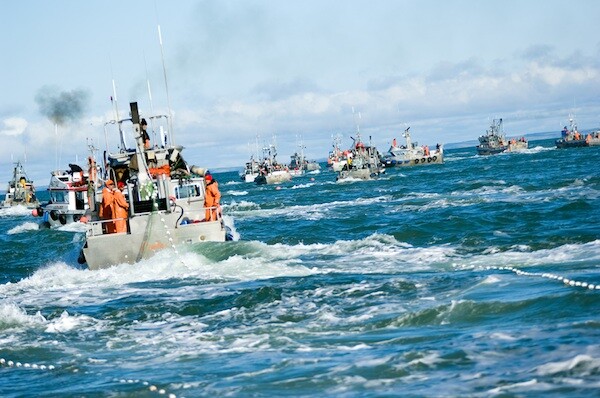Even though the final days of the sockeye salmon season in Bristol Bay hadn’t yet been fished, fishermen felt a mood swing reminiscent of last season in terms of what went into their wallets. To some, the prospects of fishing the Bay each season may come down to crunching out the cost of maintaining the commercial fishing lifestyle.
“I have a headline for this year’s Bristol Bay season,” texted a fisherman who was running his boat toward the yard for dry dock storage. “More stagger than swagger as fishermen leave Bristol Bay.”
Last year it was the gut punch of low ex-vessel prices. This season’s base prices of 8o cents per pound among brick-and-mortar processors was slightly higher than last year’s 50 cents, and some of them bumped prices to $1.40 per pound for late fish in hopes of putting up a bigger pack. But for all sectors of the industry, the harvest volume just wasn’t there.
The total run forecast for the Bay in 2024 had been set at 39 million, which was down from the 10-year average by about a third. Of that 39 million, the harvest projections had been set at 25 million. This season’s harvest (preliminary) came in above the projections at 31.5 million.
As for the harvest breakdowns by district, the fabled Nushagak District hit 11.9 million. The Naknek-Kvichak District produced 9.1 million. Egegik came in at 5.1 million, with Ugashik District kicking in another 4.3 million fish.
In terms of ex-vessel revenues, last year’s 2023 harvest generated $117 million, which crunched out to one third of the $351.7 million fishermen were paid in 2022. At an average 5.5 pounds per fish and average ex-vessel prices of $1 per pound, including incentives, this year’s revenues could add up to around $175 million, still well below the 2022 revenues.
“Lot of long faces out here,” the fisherman texted.
It’s not that the industry hadn’t entertained the notion that someday the streak of record-breaking runs would come to an end. But the nexus of meager runs and ex-vessel prices that have reverted to what they were in the early 1980s have some fishermen questioning the viability of the Bristol Bay fishery as an occupation.
To revisit history, an appreciable portion of the Bristol Bay fleet in the late 1970s and 1980s was comprised of schoolteachers and others whose mainstay professions left them with financial stability and long summer vacations. The latest economic studies (2011) across all fisheries in Alaska showed that 29 percent of some 9,900 permit holders held other jobs, and 27 percent of the 22,200 deckhands worked other jobs in the off season.
“I do wish we could do this work again, as I would also be curious if the percentage of people holding a second job has gone up in recent years,” says Joshua Warren, an economist with the State of Alaska’s Department of Labor. Funding cuts and other complications have halted more study of the issue in recent years.
Though they were sporadic, Bristol Bay’s heyday seasons of the 1980s and 1990s spawned dockside prices north of a dollar per pound and record runs and harvests. Data with Alaska’s Commercial Fisheries Entry Commission show that average earnings per drift net permit holder, adjusted for inflation, from 1977 to 1996 stretched from a low of $100,000 to $275,000, which for many created an era of fishing as a stand-alone livelihood.
Hence, the end-of-the-season swagger back then.
Since then, earnings fell sharply, below $50,000 per permit, but climbed back into six-digit figures in 2016 and hit a high of around $200,000 in 2018.
In 2021 average drift permit earnings in the Bay were $188,000. They hit an average high of $219,000 in 2022, then in 2023 they were $105,000.
The combination of weaker runs and depressed ex-vessel prices in recent years may redefine the demographics of fishermen who can afford to stay in the Bay, and moreover, determine future entrants into the fishery.
Drift permits at the advent of this year’s season had dropped to around $130,000, which is half of what they traded for two years ago.
Maddie Lightsey, a broker with Alaska Boats and Permits, in Homer, notes a severe drop in trading prices for drift permits in the bay.
"Drift permits peaked at around $260,000 in the spring of 2022," says Lightsey. "Leases topped out around $40,000. By spring of 2023, leases were going for less than $30,000, and by June they were at roughly $20,000, for a 50-percent cut from the preseason price in 2022. By fall of 2023, permit sales hit $130,000, a 50 percent cut from spring of 2022. We haven't really come back from that.”
“This spring leases went for between $14,000-$19,000, never hitting $20,000, and permits values continued to drop. Our lowest preseason sale was $128,000 and our first postseason sale was $121,500, which is the lowest we've seen those permits go for since 2016."
The Larsgaards hold multiple jobs between them to keep their fishing lifestyle afloat during the year, but they put their jobs and other commitments on hold. Like the salmon, they return each summer to ensure that their son, Jasen Jr. grows up to learn the skills of living and working the Bay’s bountiful waters.
“Even with the 50-cent price last year, raising a next generation fisherman is top priority and keeps us coming back to the Bay each summer,” she says. “To see what my son retained from last year and how he advanced this year was by far the coolest thing - his eagerness to learn and to try things. He will make a great captain in the future and we’re hoping he takes all that his dad and I teach him on the water to heart and appreciates the fishing lifestyle we love so much.”








